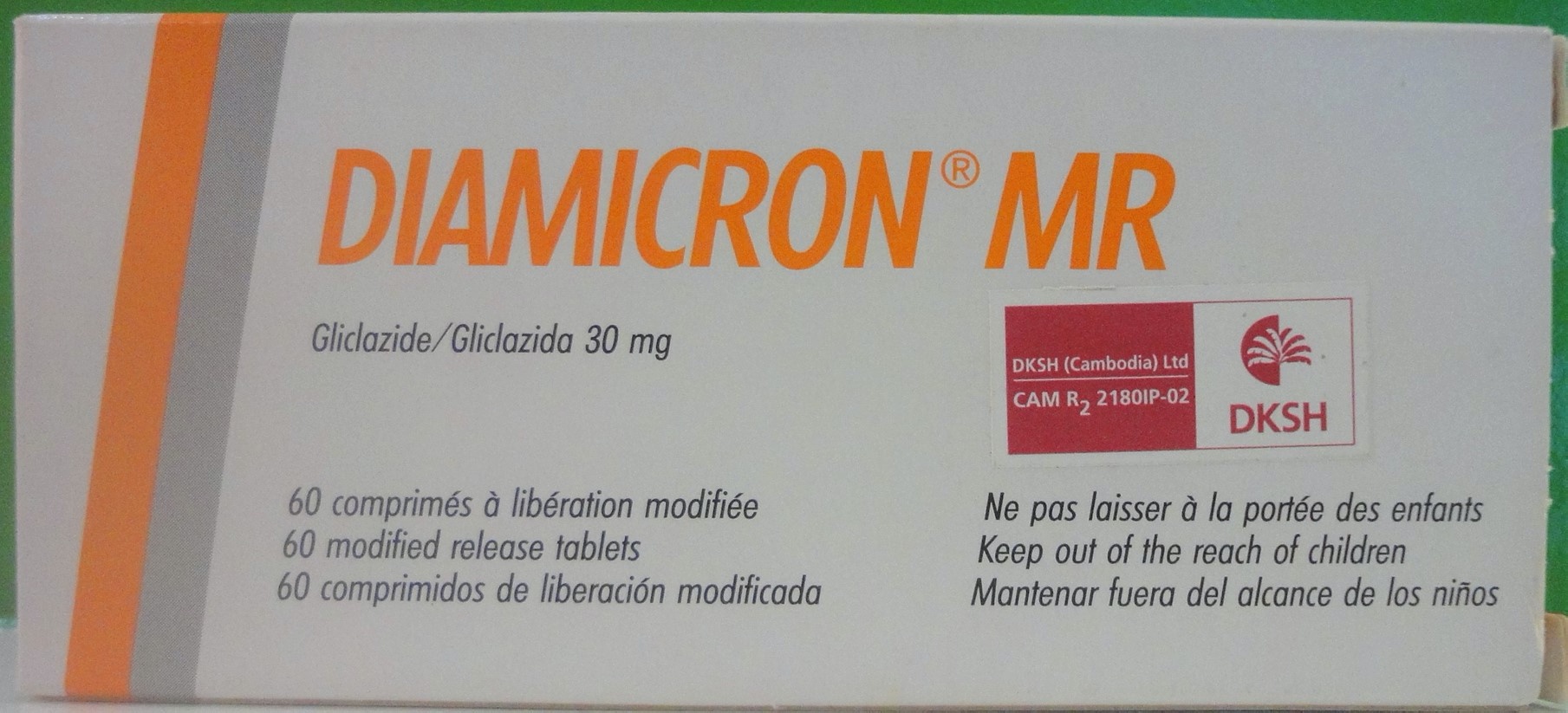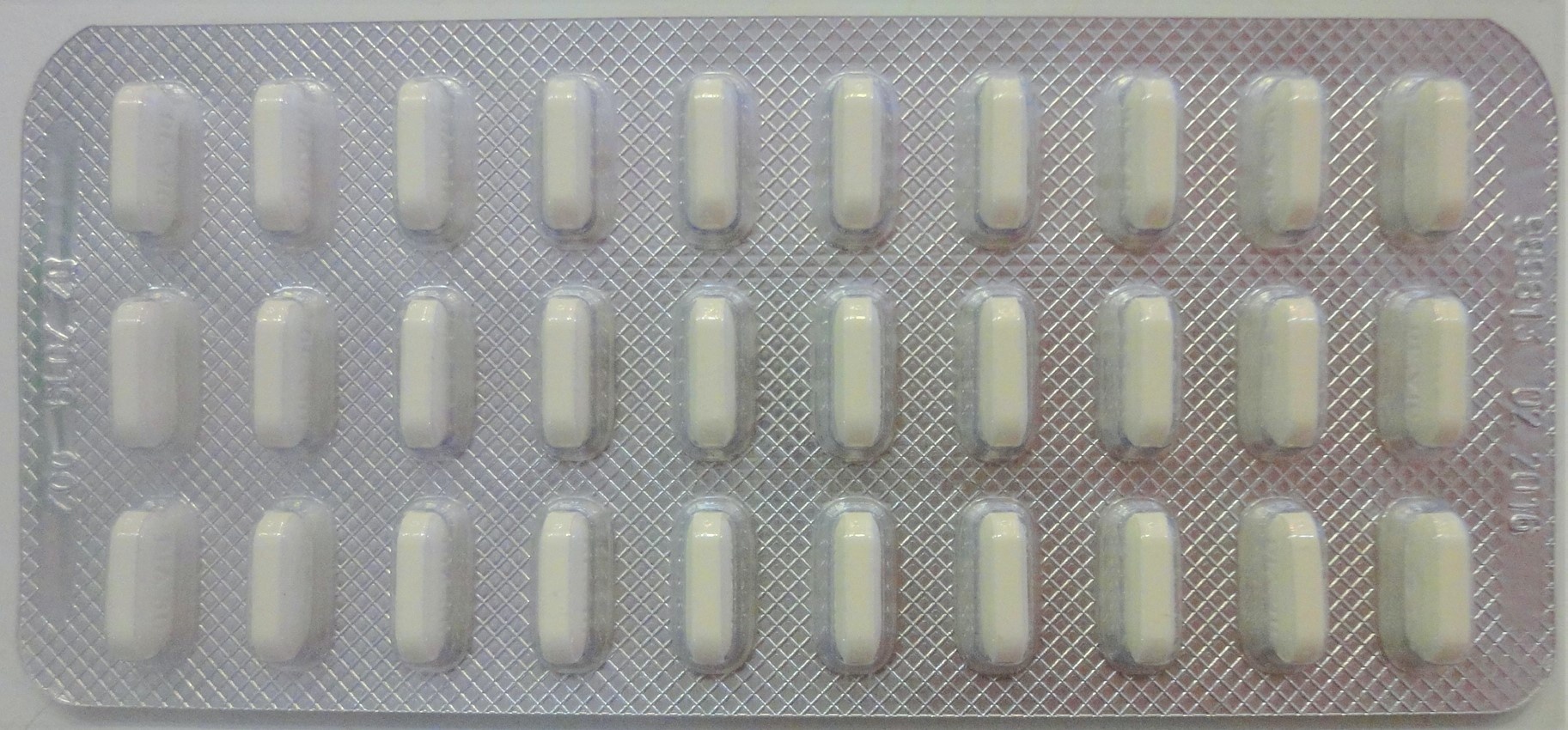DIAMICRON MR 30mg Tablet
ក្រុមហ៊ុនផលិតឱសថ:
Les Laboratories Servier Industrie, France
ក្រុមហ៊ុនចែកចាយឱសថនៅប្រទេសកម្ពុជា:
DKSH


- សារធាតុសកម្ម
- ប្រសិទ្ធិភាពព្យាបាល និង កម្រិតប្រើប្រាស់
- ហាមប្រើ
- ផលរំខាន
- អន្តរប្រតិកម្ម
- ស្ត្រីមានផ្ទៃពោះ និង ស្ត្រីបំបៅដោះកូន
- ការប្រុងប្រយ័ត្នជាពិសេស
- សកម្មភាពឱសថ បរិយាយប័ណ្ណឱសថ
-
សារធាតុសកម្ម
Gliclazide 30mg
-
ប្រសិទ្ធិភាពព្យាបាល និង កម្រិតប្រើប្រាស់
គុណភាពព្យាបាល៖
- ឱសថនេះប្រើសម្រាប់ព្យាបាលចំពោះមនុស្សពេញវ័យដែលមានជំងឺទឹកនោមផ្អែម (ប្រភេទ2) មិនទាក់ទងនឹងកម្រិតសារធាតុ Insulin ដោយរួមផ្សំជាមួយនឹងការតបអាហារ និងការធ្វើលំហាត់ប្រាណផង ក្នុងករណីដែលការប្រើឱសថនេះមិនអាចធ្វើឱ្យកម្រិតជាតិស្ករនៅក្នុងឈាមមានកម្រិតធម្មតាវិញ។
កម្រិត និងរបៀបប្រើ៖
កម្រិតធម្មតាប្រើ 1 ទៅ 4 គ្រាប់ ក្នុង1ថ្ងៃ (លេបតែម្តងក្នុងពេលអាហារពេលព្រឹក)
រយៈពេលប្រើអាស្រ័យវេជ្ជបញ្ជារបស់គ្រូពេទ្យ។
សំគាល់៖
- ឱសថនេះត្រូវលេបតាមមាត់
- លេបឱសថនេះទាំងមូលជាមួយទឹកកន្លះកែវ (ភ្លាមៗមុនបរិភោគអាហារពេលព្រឹក)
- លេបឱសថនេះក្នុងពេលបរិភោគអាហារ ដើម្បីជៀសវាងវិបត្តិក្រពះពោះវៀន
DIAMICRON MR is used in a certain form of diabetes (type 2 diabetes mellitus) in adults, when diet, exercise and weight loss alone do not have an adequate effect on keeping blood sugar at the correct level.
Dose
Always take this medicine exactly as your doctor or pharmacist has told you.
Check with your doctor or pharmacist if you are not sure.
The dose is determined by your doctor, depending on your blood and possibly urine sugar levels.
Changes in external factors (e.g. weight reduction, change in lifestyle, stress) or improvements in the blood sugar control may require changed gliclazide doses.
The recommended dose is 1-4 tablets (max. 120mg) in a single intake at breakfast time. This depends on the response to treatment.
If a combination therapy of DIAMICRON MR with metformin, an alpha-glucoside inhibitor, a thiazolidinedione, a dipeptidyl peptidase-4 inhibitor, a GLP-1 receptor agonist or insulin is initiated, your doctor will determine the proper dose of each medicine individually for you.
If you notice that your blood sugar levels are high although you are taking the medicine as prescribed, you should contact your doctor or pharmacist.
Method and route of administration.
Oral use.
Swallow your tablets whole. Do not chew them.
Take your tablet(s) with a glass of water at breakfast time (and preferably at the same time each day).
You must always eat a meal after taking your tablet(s).
-
ហាមប្រើ
ហាមប្រើ៖
- ចំពោះអ្នកជំងឺមានប្រតិកម្មអាល្លែកហ្ស៊ីជាមួយសារធាតុផ្សំណាមួយនៃឱសថនេះ ឬជាមួយពួកឱសថស្ថិតក្នុងក្រុម Sulfonylurea និងជាមួយពួកឱសថ Sulphonamides ផ្សេងទៀត
- ចំពោះអ្នកជំងឺទឹកនោមផ្អែមដែលទាក់ទងនឹងសារធាតុ Insulin (ប្រភេទ1)
- ចំពោះអ្នកជំងឺទឹកនោមផ្អែមបណ្តាលពីវិបត្តិមេតាបូលីសពួកអាស៊ីតខ្លាញ់
- ចំពោះអ្នកជំងឺទឹកនោមផ្អែមជិតសន្លប់
- ចំពោះអ្នកជំងឺខ្សោយថ្លើម ឬខ្សោយតម្រងនោមធ្ងន់ធ្ងរ
- អ្នកជំងឺកំពុងប្រើពួកឱសថប្រឆាំងមេរោគផ្សិត
- ចំពោះស្ត្រីមានផ្ទៃពោះ និងស្ត្រីបំបៅកូន
- If you are allergic to gliclazide or any of the other ingredients of this medicine, or to other medicines of the same group (sulfonylureas), or to other related medicines (hypoglycaemic sulfonamides);
- If you have insulin-dependent diabetes (type1);
- If you gave ketone bodies and sugar in the urine (this may mean you have diabetic keto-acidosis), a diabetic pre-coma or coma;
- If you have severe kidney or liver disease;
- If you are taking medication to treat fungal infections (miconazole);
- If you are breastfeeding.
-
ផលរំខាន
ផលរំខានខ្លះៗ៖ ក៏ដូចជាឱសថផ្សេងទៀតដែរ ក្នុងពេលប្រើឱសថនេះអាចបណ្តាលឱ្យមានផលរំខានដូចជា៖
- រោគសញ្ញានៃកម្រិតជាតិស្ករក្នុងឈាមចុះខ្លាំង បែកញើស ស្លេកស្លាំង ឃ្លានខ្លាងអស់កម្លាំង
- ប្រតិកម្មចំពោះស្បែក៖ កន្ទាលត្រអាក រមាស់ ស្បែកឡើងកន្ទួលក្រហម
- វិបត្តិក្រពះពោះវៀន៖ ចង្អោរ រាក ឈឺក្រពះ ទល់លាមក រលាកថ្លើម
- លទ្ធផលតេស្តឈាម មុខងារថ្លើមប្រែប្រួល
*សំគាល់៖
- ក្នុងពេលប្រើឱសថនេះ បើមានកើតឡើងនូវរោគសញ្ញាណាមួយក្រៅពីនេះត្រូវពិគ្រោះជាមួយគ្រូពេទ្យ ឬឱសថការី
*ការប្រើលើសកម្រិត៖
- បណ្តាលឱ្យមានកម្រិតជាតិស្ករនៅក្នុងឈាមថយចុះខ្លាំង៖ បែកញើស អស់កម្លាំង ឃ្លានខ្លាំង សភាពញ័រ សភាពងោកងុយ ធីងធោង ឈឺក្បាល វិបត្តិគំហើញ ។ល។
- ការព្យាបាល៖
+ ឱ្យអ្នកជំងឺបរិភោគជាតិស្ករ
+ ក្នុងករណីអ្នកជំងឺបាត់បង់ស្មារតីត្រូវបញ្ចូនអ្នកជំងឺទៅកាន់មន្ទីរពេទ្យដើម្បីសង្រ្គោះជាបន្ទាន់
The most commonly observed side effect is low blood sugar (hypoglycaemia). If left untreated these symptoms could progress to drowsiness, loss of consciousness of possibly coma.
If an episode of low blood sugar is severe or prolonged, even if it is temporarily controlled by eating sugar, you should seek immediate medical attention.
Liver disorders
There have been isolated reports of abnormal liver function, which can cause yellow skin and eyes. If you get this, see your doctor immediately.
The symptoms generally disappear if the medicine is stopped. You doctor will decide whether to stop your treatment.
Skin disorders
Skin reactions such as rash, redness, itching, hives, angioedema (rapid swelling of tissues such as eyelids, face, lips, mouth, tongue or throat that may result in breathing difficulty) have been reported. The rash may progress to widespread blistering or peeling of the skin.
Blood disorders
Decrease in the number of cells in the blood (e.g. platelets, red and white blood cells) which may cause paleness, prolonged bleeding, bruising, sore throat and fever have been reported. These symptoms usually vanish when the treatment is discontinued.
Digestive disorders
Abdominal pain, nausea, vomiting, indigestion, diarrhoea and constipation. These effects are reduced when DIAMICRON MR is taken with a meal, as recommended.
Eye disorders
Your vision may be affected for a short time especially at the start of treatment. This effect is due to changes in blood sugar levels.
As for other sulphonylureas, the following adverse events have been observed: cases of severe changes in the number of blood cells and allergic inflammation of the wall of blood vessel, reduction in blood sodium (hyponatraemia), symptoms of liver impairment (e.g. jaundice) which in most cases disappointed after withdrawal of the sulfonylureas, but may lead to life-threatening liver failure in isolated cases.
-
អន្តរប្រតិកម្ម
- ក្នុងពេលប្រើឱសថនេះ មុនប្រើឱសថនេះផ្សេងទៀតត្រូវពិគ្រោះជាមួយគ្រូពេទ្យ ឬឱសថការីដូចជា៖ Danazol, hormonal drug, corticoids, diuretics, miconazole
- ពួកឱសថដែលប្រើដោយគ្មានវេជ្ជបញ្ជា ឬសារធាតុអាល់កុល
The blood sugar lowering effect of gliclazide may be strengthened and signs of low blood sugar levels may occur when one of the following medicines is taken:
- other medicines used to treat high blood sugar (oral antidiabetics, GLP-1 receptor agonists or insulin),
- antibiotics (e.g. sulphonamides, clarithromycin),
- medicines to treat high blood pressure or heart failure (beta-blockers, ACE-inhibitors such as captopril or enalapril),
- medicines to treat fungal infections (miconazole, fluconazole).
- medicines to treat ulcers in the stomach or duodenum (H2 receptor antagonists),
- medicines to treat depression (monoamine oxidase inhibitors),
- painkiller or antirheumatics (phenylbutazone, ibuprofen),
- medicines containing alcohol.
The blood glucose lowering effect of gliclazide may be weakened and raised blood sugar levels may occur when one of the following medicines is taken:
- medicines to treat disorders of the central nervous system (chlorpromazine),
- medicines reducing inflammation (corticosteroids),
- medicines to treat asthma or used during labour (intravenous salbutamol, ritodrine and terbutaline),
- medicines to treat breast disorders, heavy menstrual bleeding and endometriosis (danazol).
- St John's Wort - Hypericum preforatum - preparations
DIAMICRON MR may increase the effects of medicines which reduce blood clotting (eg: warfarin).
DIAMICRONMR can be taken with food and non-alcoholic drinks. Drinking alcohol is not recommended as it can alter the control of your diabetes in an unpredictable manner.
-
ស្ត្រីមានផ្ទៃពោះ និង ស្ត្រីបំបៅដោះកូន
ហាមប្រើចំពោះស្រ្តីមានផ្ទៃពោះ និងស្រ្តីបំបៅកូន។
DIAMICRON MR is not recommended during pregnancy. If you are pregnant or breast-feeding, think you may be pregnant or are planning to have a baby while taking this medicine, inform your doctor so that he may prescribe a more suitable treatment for you.
You must not take DIAMICRON MR while you are breastfeeding.
-
ការប្រុងប្រយ័ត្នជាពិសេស
- ក្នុងពេលប្រើឱសថនេះអាចបណ្តាលឱ្យកម្រិតជាតិស្ករនៅក្នុងឈាមចុះខ្លាំង
- ដើម្បីជៀសវាងកម្រិតជាតិស្ករនៅក្នុងឈាមចុះខ្លាំងពេល ក្នុងពេលប្រើឱសថនេះជំងឺត្រូវដឹង៖
+ បរិភោគអាហារតាមធម្មតា ជាពិសេសអាហារពេលព្រឹក
+ មិនត្រូវអាក់ខានក្នុងការបរិភោគអាហារទេ
+ មិនត្រូវតមជាតិស្ករហួសកម្រិតពេក
+ លេបថ្នាំឱ្យបានទៀងទាត់តាមវេជ្ជបញ្ជា (លេបម្តង 1គ្រាប់នៅពេលអាហារពេលព្រឹក)
+ ត្រូវអនុវត្តតាមការណែនាំរបស់គ្រូពេទ្យក្នុងការតមអាហារឱ្យបានទៀងទាត់តាមការណែនាំរបស់គ្រូពេទ្យ
- ត្រូវជម្រាបគ្រូពេទ្យឱ្យបានដឹងក្នុងករណី៖
+ មានការវះកាត់ ការប៉ះទង្គិច គ្រុន ការបង្កជំងឺ ឬការពិបាកហូបអាហារ
+ មានបំណង់ចង់មានកូន (គភ៌)
+ មានប្រើឱសថផ្សេងទៀតជាពិសេសពួកឱសថ Anti-inflammatory, beta blockers, corticoid
- ក្នុងពេលប្រើឱសថនេះត្រូវជៀសវាងផឹកស្រា ឬភេសជ្ជៈដែលមានជាតិអាល់កុល
- ចំពោះអ្នកកំពុងបញ្ជាយាន្ត ឬគ្រឿងម៉ាស៊ីន គួរជៀសវាង ឬប្រើឱសថនេះដោយប្រុងប្រយ័ត្ន
You should observe the treatment plan prescribed by your doctor to achieve proper blood sugar levels. This means, apart from regular tablet intake, you observe the dietary regimen, have physical exercise and, where necessary, reduce weight.
During gliclazide treatment regular monitoring of your blood (and possibly urine) sugar level and also your glycated haemoglobin (HbA1c) is necessary.
In the first few weeks of treatment the risk of having reduced blood sugar levels (hypoglycaemia) may be increased. So particularly close medical monitoring is necessary.
Low blood sugar (hypoglycaemia) may occur:
- if you take meals irregularly or skip meals altogether;
- if you are fasting,
- if you are malnourished,
- if you change your diet,
- if you increase your physical activity and carbohydrate intake does not match this increase,
- if you drink alcohol, especially in combination with skipped meals;
- if you take other medicines or natural remedies at the same time,
- if you take too high doses of gliclazide,
- if you suffer from particular hormone-induced disorders (functional disorders of the thyroid gland, of the pituitary gland or adrenal cortex),
- if your kidney function or liver function is severely decreased.
If you have low blood sugar you may have the following symptoms:
Headaches, intense hunger, nausea, vomiting, weariness, sleep disorders, restlessness, aggressiveness, poor concentration, reduced alertness and reaction time, depression, confusion, speech or visual disorders, tremor, sensory disturbances, dizziness and helplessness.
The following signs and symptoms may also occur: sweating, clammy skin, anxiety, fast or irregular heartbeat, high blood pressure, sudden strong pain in the chest that may radiate into nearby areas (angina pectoris).
If blood sugar levels continue to drop, you may suffer from considerable confusion (delirium), develop convulsions, lose your self-control, your breathing may be shallow and your heartbeat slowed down, you may become unconscious.
In most cases, the symptoms of low blood sugar vanish very quickly when you consume some form of sugar, e.g. glucose tablets, sugar cubes, sweet juice, sweet juice, sweetened tea.
You should therefore always carry some form of sugar with you (glucose tablets, sugar cubes). Remember that artificial sweeteners are not effective. Please contact your doctor or the nearest hospital if taking sugar does not help or if the symptoms recur.
Symptoms of low blood sugar may be absent, less obvious or develop very slowly or you are not aware in time that your blood sugar level has dropped. This may happen if you are en elderly patient taking certain medicines (e.g. those acting on the central nervous system and beta-blockers).
If you are in stress situations (e.g. accident, surgical operations, fever, etc.) your doctor may temporarily switch you to insulin therapy.
Symptoms of high blood sugar (hyperglycaemia) may occur when gliclazide has not yet sufficiently reduced the blood sugar, when you have not complied with the treatment plan prescribed by your doctor or in special stress situations. These may include thirst, frequent urination, dry mouth, dry itchy skin, skin infections and reduced performance.
If these symptoms occur, you must contact your doctor or pharmacist.
If you have a family history of or know you have the hereditary condition Glucose-6-Phosphate-Dehydrogenase (G6PD) deficiency (abnormality of red blood cells), lowering of the haemoglobin level and breakdown of red blood cells (haemolytic anaemia) can occur.
DIAMICRON MR is not recommended for use in children due to a lack of data.
-
សកម្មភាពឱសថ
DIAMICRON MR is a medicine that reduces blood sugar levels (oral antidiabetic agent belonging to the sulfonylurea group).
DIAMICRON MR is used in a certain form of diabetes (type 2 diabetes mellitus) in adults, when diet, exercise and weight loss alone do not have an adequate effect on keeping blood sugar at the correct level.
*ព័ត៌មានឱសថត្រូវបានរៀបរៀងដោយ អ៊ីម៉ាតុគឹ មេឌីក (ខេមបូឌា) ដោយផ្អែកលើប្រភពព័ត៌មានខាងក្រោម។ សម្រាប់ព័ត៌មានលម្អិត សូមស្វែងរកនៅក្នុងក្រដាសព័ត៌មាននៃឱសថនីមួយៗ ឬ សាកសួរទៅកាន់ក្រុមហ៊ុនឱសថឬតំណាងចែកចាយនៃឱសថនីមួយៗ។
ប្រភពព័ត៌មាន៖
- ក្រដាសព័ត៌មាននៃឱសថសម្រាប់អ្នកជំនាញវេជ្ជសាស្ត្រដែលប្រើប្រាស់នៅប្រទេសជប៉ុន (Pharmaceutical and Medical Devices Agency, Pmda): https://www.pmda.go.jp
- ព័ត៌មានសង្ខេបនៃឱសថសម្រាប់អ្នកជំងឺដែលប្រើប្រាស់នៅប្រទេសជប៉ុន: http://www.rad-ar.or.jp
